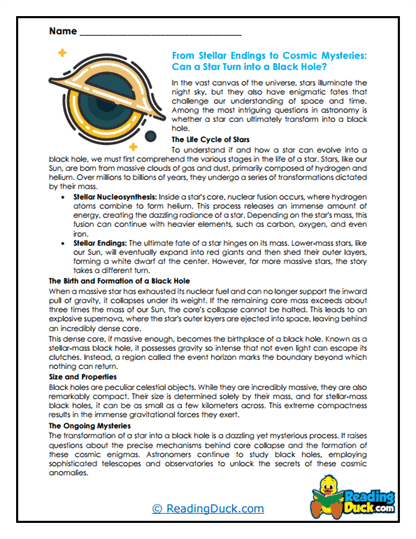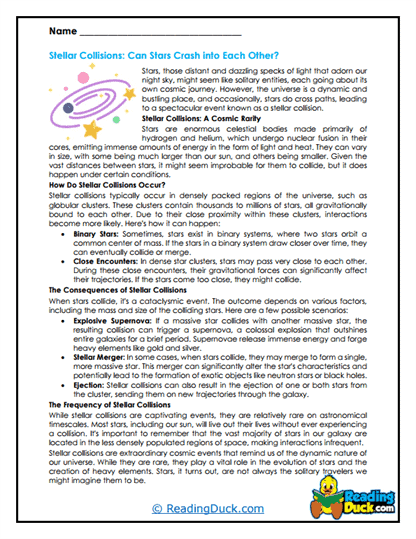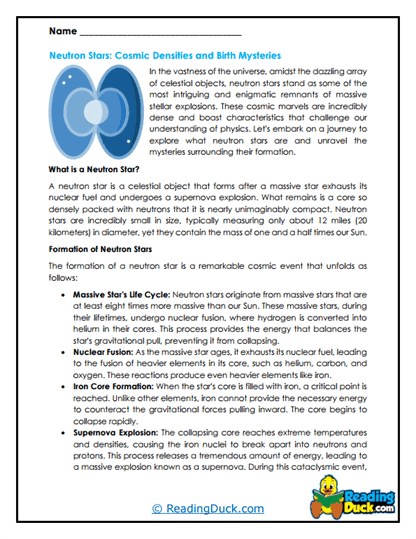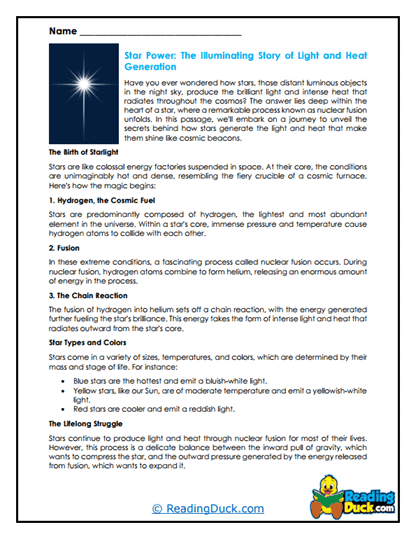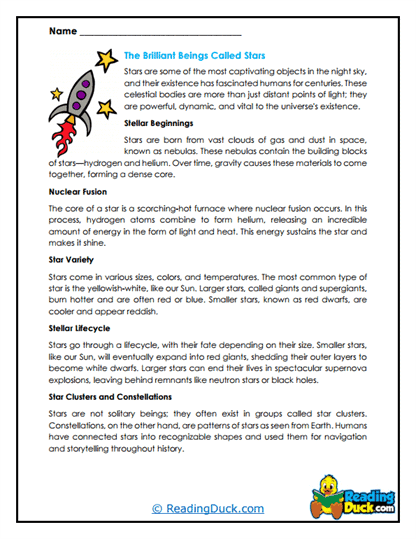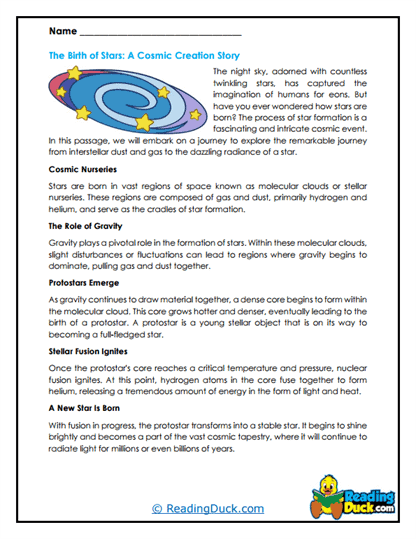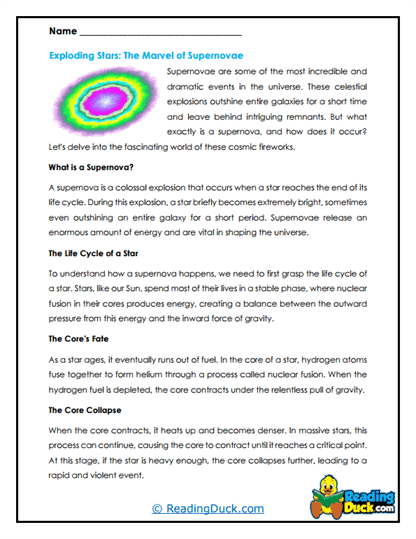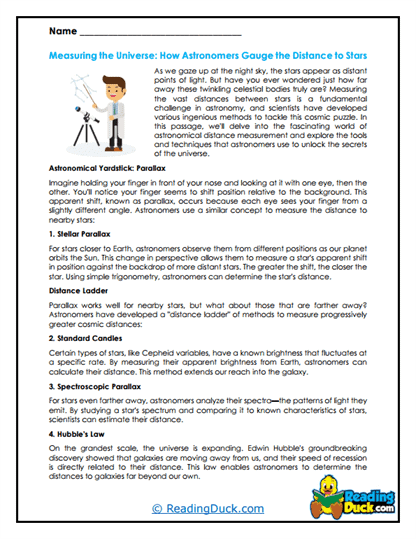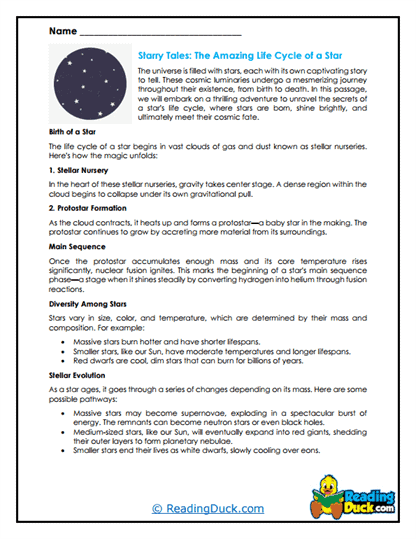Stars Worksheets
About Our Stars Worksheets
Our collection of Stars worksheets offers an exciting and educational journey into the world of Astronomy, focusing on one of its most fundamental and captivating topics—stars. Stars are the building blocks of the universe, lighting up the night sky and fueling the processes that sustain life. These worksheets are designed to help students explore the fascinating science behind stars, enhancing their understanding through engaging reading passages and a variety of questions that encourage critical thinking and personal reflection.
Each worksheet set includes the following key components:
- Multiple Choice Questions: After reading the passage, students can test their comprehension with multiple-choice questions. These questions are designed to assess their understanding of the main ideas and details presented in the reading material, ensuring they grasp the fundamental concepts.
- Short Answer Questions: In this section, students are prompted to write out their answers, encouraging them to explain concepts in their own words. This practice helps solidify their understanding and ensures they can articulate what they’ve learned.
- Open-Ended Questions: These questions invite students to share their personal thoughts, opinions, and reflections on the material. This section is designed to foster critical thinking and allow students to connect more deeply with the content.
Each worksheet is accompanied by a detailed answer key to support educators and parents. The worksheets are available in PDF format, making them easy to view electronically, download, and print.
Illuminating the Universe: An Introduction to Stars
When introducing students to the topic of stars, it’s important to start with an overview of what stars are and why they are so important in the study of Astronomy. A star is a massive, luminous sphere of plasma held together by gravity, and it is the primary source of light and heat in the universe. Stars are born from clouds of gas and dust, live for millions to billions of years, and eventually die, often in spectacular ways. Understanding stars is crucial because they influence the formation of galaxies, the creation of elements, and the potential for life.
To help students gain a comprehensive understanding of stars, we can explore the topic through the following key areas:
- The Lifecycle of Stars: Stars go through various stages of life, each with unique characteristics and phenomena:
- Star Formation: Stars are born in nebulae, which are vast clouds of gas and dust. Under the force of gravity, these clouds collapse to form protostars, which eventually ignite nuclear fusion in their cores, becoming main-sequence stars.
- Main-Sequence Stars: During this stable phase, a star fuses hydrogen into helium in its core, producing the light and heat we observe. Our Sun is currently in the main-sequence phase, which lasts for most of a star’s life.
- Red Giants and Supergiants: As stars exhaust their hydrogen fuel, they expand and cool, becoming red giants or supergiants. This stage is characterized by the fusion of heavier elements in the star's core.
- Stellar Death: The final stages of a star’s life depend on its mass. Low-mass stars like the Sun shed their outer layers and leave behind a white dwarf, while massive stars can explode in a supernova, leaving behind a neutron star or black hole.
- Types of Stars: Stars come in various types, each with distinct characteristics:
- Dwarf Stars: These stars, including red and white dwarfs, are smaller and cooler than stars like the Sun. Despite their size, dwarf stars can be incredibly long-lived.
- Giant and Supergiant Stars: These are larger and more luminous than main-sequence stars. They often end their lives in dramatic supernova explosions.
- Variable Stars: These stars change in brightness over time due to pulsations, eruptions, or eclipses by companion stars. Studying variable stars helps astronomers understand stellar processes and distances in the universe.
- The Sun, Our Closest Star: The Sun is a typical main-sequence star, but its proximity to Earth makes it the most important star for us to study. It provides the light and heat necessary for life, drives the climate and weather, and influences space weather in the form of solar flares and coronal mass ejections. Understanding the Sun helps students appreciate the role of stars in sustaining life and shaping planetary environments.
- Star Clusters and Constellations: Stars are often found in groups, and humans have observed patterns in the night sky for millennia:
- Star Clusters: These are groups of stars that form together from the same cloud of gas and dust. There are two main types: open clusters, which are loosely bound and found in the arms of spiral galaxies, and globular clusters, which are tightly bound and found in the halos of galaxies.
- Constellations: Constellations are patterns of stars that have been identified and named by cultures throughout history. Learning about constellations helps students connect with the way humans have navigated and understood the night sky.
- Stellar Evolution and the Creation of Elements: Stars play a critical role in the creation of elements through nuclear fusion. During their lives, stars fuse lighter elements into heavier ones, a process that culminates in the creation of elements like carbon, oxygen, and iron. In the final stages of massive stars, supernova explosions distribute these elements throughout the galaxy, seeding future generations of stars and planets. Understanding this process helps students appreciate the connection between stars and the elements that make up everything around us.
By exploring these aspects of stars, students can develop a well-rounded understanding of these essential celestial objects. These worksheets will guide them through the science of stars, sparking curiosity and encouraging them to think critically about the role of stars in the universe.
Integrating These Worksheets in a Learning Curriculum
Integrating our Stars worksheets into a school or homeschool curriculum provides numerous opportunities to enhance students' understanding of this foundational topic in Astronomy. Here are some practical ideas on how educators and parents can effectively use these worksheets in various educational settings:
- Unit-Based Learning: These worksheets can be used as part of a broader unit on Astronomy or Space Science. After introducing students to basic concepts such as the solar system and the different types of celestial bodies, the topic of stars can be explored in greater depth, covering their lifecycle, types, and role in the cosmos. The worksheets can serve as the foundation for discussions, experiments, and further research on stars and their significance.
- Classroom Discussions and Group Activities: Encourage students to work in pairs or small groups to discuss the reading passages and answer the questions together. This collaborative approach helps students articulate their thoughts, listen to different perspectives, and deepen their understanding of the material. The open-ended questions, in particular, are excellent for sparking class discussions, where students can share their ideas and engage in debates about the nature of stars and their impact on the universe.
- Research Projects and Presentations: After completing the worksheets, students can be assigned to research and present on specific types of stars, famous star clusters, or the lifecycle of stars. They can also explore topics like the significance of the Sun to life on Earth, the history of human understanding of stars, or the technological advances that have allowed us to study stars in greater detail. These projects can culminate in presentations, reports, or creative displays, allowing students to showcase their knowledge and enthusiasm for the subject.
- Multimedia Integration: Pair the worksheets with multimedia resources to create a more immersive learning experience. For example, students can watch documentaries or educational videos on the formation of stars, the lifecycle of the Sun, or the discovery of exoplanets before completing the worksheets. This combination of visual and textual learning can cater to different learning styles and reinforce the concepts covered in the worksheets.
- Homework Assignments: The worksheets are ideal for homework assignments, giving students the opportunity to engage with the material independently. The reading passages and questions are designed to be both challenging and accessible, making them perfect for self-directed study. The answer key allows for easy review, helping students to check their understanding and correct any misconceptions.
- Assessment Tools: These worksheets can be used as both formative and summative assessment tools. Teachers can use the multiple-choice and short answer questions to gauge students' understanding of stars, while the open-ended questions can assess their ability to think critically and reflect on the material. This balanced approach to assessment ensures that students' knowledge is tested comprehensively.
- Observation and Field Activities: Organize an outdoor activity where students can observe the night sky, identify stars and constellations, or use telescopes to view different types of stars. Before the observation, use the worksheets to educate students about what they will see and what to look for. After the observation, have students complete the worksheets to reflect on their experience and connect it to what they've learned.
By incorporating these Stars worksheets into the curriculum, teachers and parents can provide students with a comprehensive and engaging learning experience. These worksheets are designed to help students explore the wonders of stars, develop critical thinking skills, and foster a lifelong curiosity about the universe. Whether used in the classroom or at home, these resources will inspire students to look up at the night sky with a sense of wonder and a desire to learn more about the stars that illuminate the cosmos.
